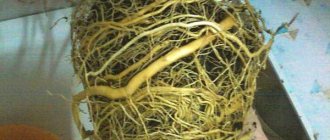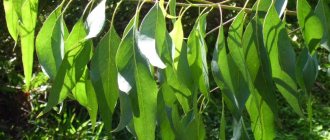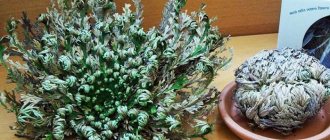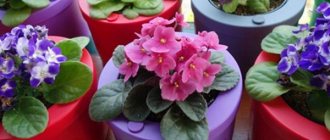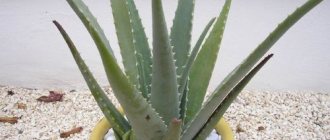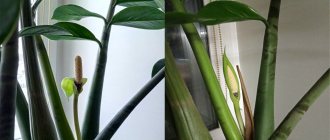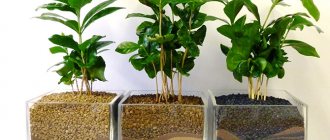Someone called this plant the tree of happiness, and someone saw a resemblance to a dragon and the tree became a dragon. From Latin the word dracaena is translated as female dragon. Perhaps this name is due to the fact that the cinnabar-red resin of dracaena resembles the blood of a fairy-tale monster in its scarlet color. Even its name is translated from Greek as dragon’s blood.
The genus Dracaenaceae belongs to the Asparagus family and includes several dozen species. In the wild, most of them are distributed in Africa and Asia. Only one wild species is found in Central America. Despite such an ominous name, the plant is very popular in indoor floriculture. Let's try to find out how to breed dracaena at home.
Where did dracaena come from, and what types can you grow at home?
The homeland of dracaena is the tropical forests of America, Africa and Asia, as well as the Canary Islands. It can be safely classified as a palm plant; it looks like a palm tree: under favorable conditions it can reach 20 meters in length, while the trunk is most often bare, and the foliage forms a crown in the upper part. The root system is smooth and even with a hint of rust. There are several decorative types of dracaena that are grown at home.
Dracaena fragrant (Frangrance, Malaika) - the flower received its name due to the pleasant aroma emanating from the inflorescence. When flowering, more than one flower is formed; the palm tree has a peduncle that grows in the center of the rosette; small flowers appear on it in large numbers, which are the source of the smell. At home, fragrant dracaena blooms very rarely, only in ideal conditions. A flowering plant can be found either in its homeland or in a botanical garden.
As a houseplant, fragrant dracaena is found both tall and dwarf. The leaves are succulent, dense, and have a refined curve. They can reach half a meter in length with a width of 10 cm. The leaves form a crown at the top of the trunk, which becomes bare due to the falling of leaves during plant growth. Often among the varieties of broad-leaved fragrant dracaena there are specimens with decorative leaf colors: Lindenii, Massangeana, Surprise.
Derema dracaena grows tall, even in a small pot. It differs from other species in the abundance of succulent foliage on the trunk. Some varieties have light green leaves 5 cm wide and about 50 cm long. Other varieties have variegated leaves on a green background. The foliage shape is elongated with a smooth surface. This palm tree will not please you with its flowering; all that remains is to enjoy its exotic appearance. The following varieties of Derham dracaena have been bred for home keeping: Janet Craig Compacta, Lemon Lime, Warneckii, White Stripe.
Among other species, the most common is dracaena marginata. In its homeland (the island of Madagascar) it can grow up to 6 meters in height. Due to the decorative appearance of its long, thin leaves, this variety is sometimes called dragonwood. The length of the leaf reaches 70 cm, the width is from 1 to 1.5 cm. Flower growers call it Marginata. At home, the plant is kept in containers. As it grows, the trunk becomes bare, and decoratively colored leaves form a crown. In its homeland, the plant not only blooms, but also bears fruit. At home, a racemose inflorescence can be seen extremely rarely. The varieties Colorama, Sandera, Bicolor, and Tricolor are popular among gardeners.
Dracaena dragon can grow up to 18 meters in height with a trunk diameter of 5 meters. At home its height does not exceed 1.5 meters. The foliage is oblong, elastic, pointed at the ends. Each shoot is crowned with a bunch of leaves 60 cm long and 3 cm wide. If the flower is well lit, the edging becomes pink. As they grow, the lower leaves turn yellow and fall off.
Dracaena Godsefa is impressive in its appearance, as it is not similar to other varieties of the plant. It grows as a bush with leaves about 10 cm long and shaped like an egg. It grows up to 70 cm in height. The leaves have varied shades: from greenish to beige. Has shoots in the form of wire. It begins to bloom almost immediately after planting with fragrant light green flowers. After flowering, fruits appear in the form of berries. Godsefa is not afraid of the temperature dropping.
Dracaenas have a positive effect on the human nervous system, give a good mood and bring peace of mind.
Creating tropics in an apartment - how much light does a palm tree need?
Dracaena is a tropical plant and needs warmth and moisture. The plant can grow in partial shade, but it is better to place it in a room in a well-lit place. At the same time, we protect it from direct sunlight and provide diffused lighting. The need for lighting depends on the variegation of the leaves. Varieties with variegated foliage need a lot of light; green leaves do not need a lot of light. If dracaena does not receive enough light, it grows and develops poorly.
If the palm tree is on the windowsill, then the windows should face the east or west side. If the windows face south, then we provide shading. Dracaena will not live long on a north window. These recommendations should be taken into account when choosing a location for the plant. The flower does not like heat either. In summer, a comfortable temperature for her will be from 20 to 25 degrees, in winter - from 15 to 18. If the air in the room is dry, place a container of water next to the pot, and spray the leaves more often with a spray bottle. We maintain indoor air humidity within 60-70%. We regularly ventilate the room, since dracaena needs fresh air, but it does not like drafts.
Dracaena in natural and home conditions
Dracaena is a palm tree for busy and not too diligent gardeners. Although it is not even related to palm trees. Only in appearance it is very similar: a slender bare stem with a cap of leaves at the top.
Dracaenas in their homeland are tall, long-lived trees
In nature, dracaena lives for a very long time. On the island of Tenerife there grew a sacred dragon tree 23 meters high with a trunk girth of 15 meters. Inside the hollow of this giant, local residents who worshiped dracaena built an altar. According to biologist and teacher N.M. Verzilin, who described this tree in the last century, this tree could have been seen by sailors back in 1402. On the same island, a 21-meter-tall dracaena was found, still alive to this day, which is supposedly over 300 years old.
The false Dracaena palm differs from the true ones by its unpretentious disposition, modest requirements for living conditions, and the ability to forgive flower growers for their mistakes.
Dracaena bordered is the most popular species in indoor floriculture.
This plant, especially marginata and dragonfruit, can add some greenery to dark corners of your home. It grows without problems in partial shade. Varieties with variegated leaves do best in bright, but diffused light. Direct rays can burn delicate greens. Dracaena loves artificial lighting, so it often decorates offices.
Dracaena does not require any special temperature; moderate, room temperature is suitable for it: +25 and above in summer, 18–20 degrees in winter. But the dracaena needs to be protected from sudden changes and drafts - after all, it is a southerner.
It is advised to regularly spray dracaenas and humidify the air for them. But this fully applies only to particularly delicate species, for example, fragrant and reflexed. As practice shows, the plant has already acclimatized to the dryness of our apartments. Although, of course, a warm shower from a spray bottle will be welcome. Dracaena will also like hygienic wiping of leaves from dust.
Dracaena does not like waterlogged soil, it will prefer a slight drought
Summer watering of dracaena should be plentiful: the hotter, the more. In winter, water is given limitedly, but the soil is not brought to complete dryness. The lower the temperature, the less humidification. Excess water at the roots leads to disease. Therefore, it is useful to loosen the top layer of soil so that air can penetrate inside the pot unhindered.
Over the years, dracaena, like real palm trees, loses its lower leaves. This is a natural phenomenon. You should be alarmed if leaf fall becomes widespread.
To stimulate the lateral buds and rejuvenate the dracaena, it is recommended to prune it. For healthy plants, at least 30 cm tall, the top is cut off with a sharp knife, about 5–6 cm. It can then be rooted. The wound must be lubricated with garden varnish or sprinkled with coal. In about a month, new shoots should appear under the cut.
Video: how to care for a palm tree for the lazy
Watering and fertilizing - complete nutrition
In order for the plant to have lush greenery and a healthy appearance, it must be properly watered. Features of watering depend on the specific variety, but there are general recommendations. The growth period for palm trees occurs in the spring-summer season, so at this time we water abundantly. Between waterings we take a break of about 8 days, the surface layer should dry out by 2-3 cm. We take soft water for irrigation; it is better to boil or filter tap water. It is important that the water contains as few impurities as possible; fluorine and its compounds are especially harmful. Before each watering, we loosen the soil.
In autumn, we reduce watering, as the soil dries more slowly. In winter, the plant rests, so it is enough to water it several times a month. The reference point is the soil. If the plant is located near a heating device, the soil dries faster and you have to water it more often. Frequent watering can have a detrimental effect on the root system of the dracaena, which can begin to rot, resulting in the death of the flower. Therefore, be careful when watering. We spray the leaves regularly, wipe the leaves once a month to remove dust and dirt. Sometimes it is useful for a plant to give it a warm shower.
We select complex fertilizers or mixtures for deciduous plants for dracaena, which are sold in specialized stores. It is better to buy fertilizers in liquid form. Add them to the water and water the flowers with this solution. We feed the plants during the period when they are actively growing - from early spring to autumn. We fertilize once every 2 weeks, in the winter season - no more than once a month.
To accelerate growth, dracaena needs phosphorus, nitrogen and potassium. When choosing fertilizers, pay attention that the named elements are present in the composition; they must be in a ratio of 1: 3: 3, as listed. The drug Zircon, which is intended for growing palm trees, is popular. We dilute it according to the instructions and add it to the water for irrigation.
Replanting and pruning - to make the plant comfortable
After purchasing the dracaena, we give it time to adapt - about 21 days, then transplant it into another pot. We carry out the transshipment carefully together with a lump of earth, in order to avoid damage to the root system. We fill the free space with pre-purchased soil or prepared soil ourselves. If you prepare the mixture yourself, take the following components:
- turf land;
- leaf soil;
- peat;
- humus;
- coarse sand.
Mix all components in equal proportions. For disinfection, add wood ash. We put drainage at the bottom of the pot. When choosing a flowerpot, we evaluate the size of the plant. If its height is 40 cm, then we take a container with a diameter of 16 cm.
We replant a young palm tree regularly once a year; an old plant does not need frequent replanting, so it is better to replant it once every 2-3 years. The best time for replanting is considered to be the time when the plant comes out of dormancy: late winter-early spring. We transplant the plants into containers 2-3 cm larger than the previous one. Add the required amount of soil, water and place in a warm place. When the soil settles, add more soil if necessary.
To give the palm a beautiful shape or to prevent the spread of the disease, we perform pruning, which is best done in winter, when the plant is dormant. For pruning we use garden shears. Before the procedure, we must disinfect the instrument. After cutting, sprinkle the cut area with wood ash or crushed coal. If you cut off the top of a palm tree, new shoots will begin to grow from the sides.
If we do pruning for branching, then we prune plants that have reached a height of 30 cm. We cut the shoots 6 cm below the last leaves or leave the height necessary to form the shape of the bush. After 17-25 days, buds appear under the cut, from which side shoots subsequently grow. After pruning, we provide the plant with good lighting, watering and spraying so that new branches grow better.
How to plant or transplant indoor dracaena
Dracaenas are usually replanted every two years. But this rule can be broken. If the plant is developing well and does not cause concern, it is better not to disturb it. Even the most skilled transplant is a lot of stress for the plant.
This dracaena does not need replanting yet
The root system will inevitably be injured during this operation. But in some situations, a transplant is the only way out.
When is it necessary to replant dracaena:
- The plant has clearly outgrown the pot, the roots are climbing out of the drainage holes and lying in loops on the bottom, this can be seen when removing the dracaena from the container.
- Dracaena lives in a pot for more than three years, there is no growth. The leaves began to turn yellow en masse.
- Signs of waterlogging of the soil are noticeable and it is turning sour. There is a suspicion of root rot. Midges are flying around the pot, and parasites have been spotted in the soil.
- The plant was recently purchased, it is in a pot with shipping soil.
This dracaena suffers from overwatering and root rot; replanting can help it
Which pot to choose
The root system of dracaena develops deep and has few lateral shoots. Therefore, when choosing a new pot, pay attention to tall and narrow containers. After replanting, there should be enough space below for roots to develop.
Dracaena needs a tall pot
The size of the container depends on the size of the dracaena. A guide here can be a plant 40–45 cm tall, which requires a pot with a diameter of 15–20 cm. Every 2–3 years, the diameter should increase by 2–3 cm, no more. You should not save money and buy dishes for dracaena to grow. The roots will not be able to inhabit a large volume of soil, the moisture will stagnate and a putrefactive process will begin.
The pot on the left is beautiful, but for the dracaena that stands next to it, it is too big
There is no point in thinking for a long time about what is better: plastic or ceramics; the picky dracaena grows equally well in dishes made of any material. So here rely only on your taste and finances.
Dracaena grows well in containers made of any material, but it looks more impressive in ceramics
But be sure to check the drainage holes in the pot, and if there are none, be sure to make them. They should be large enough to rid the plant of unnecessary moisture.
Required soil and drainage
Dracaenas are not capricious in their choice of soil. False palms like a breathable, moderately nutritious, neutral or slightly acidic (6–6.5 pH) substrate with a small addition of loosening ingredients and peat.
Ready-made soil prepared specifically for dracaena, but still don’t be too lazy to look at the composition indicated on the package before planting
You can buy specialized soil for dracaenas or palm trees, or you can make a mixture yourself. Here are some recipes:
- turf soil - 2 parts, leaf and compost soil - 1 part each, peat - 0.5;
- for 2 shares of turf land - 1 deciduous and 0.5 coarse sand;
- for 2 shares of turf land, 1 share of sand, peat and humus soil;
- an equal share of leaf soil, high peat, chopped moss and half a share of perlite or coarse sand;
- two parts rotted compost or humus, one part leaf soil, sand or vermiculite;
- turf soil, greenhouse and leaf humus in equal shares, half of the share is river sand;
- Dilute universal soil for indoor plants by half with garden soil, add a little crushed moss.
3 propagation methods - choose any
Dracaena has another name - the tree of happiness. The American Indians have a legend about how a young warrior fell in love with the chief’s daughter and was able to marry her after he stuck a stick in the ground and on the fifth day, after regular watering, leaves appeared on it. This legend is not only about a beautiful love story, but also about one of the methods of propagation of dracaena.
Dracaena reproduces in three ways:
- seeds;
- bends;
- cuttings.
The best time for these procedures is spring.
Seed method
The seed propagation method is the most labor-intensive. We grow dracaena from scratch from purchased seeds:
- First we germinate the seeds. To do this, place them in water at a temperature of 26-30 degrees or a stimulating solution for 24 hours.
- When the sprouts appear, we make depressions in the previously prepared soil, put the seeds in them and sprinkle them with earth.
- To create greenhouse conditions, cover with film and place the container in a warm, sufficiently lit place.
- We regularly ventilate and water the seeds.
- If you follow the growing rules, seedlings should appear in one and a half to two months. When the sprouts grow to a height of 6-7 cm, they need to be planted in permanent flowerpots.
It will take about 2 years to grow dracaena from seeds.
Propagation by cuttings
For cuttings, you need to take a shoot from an adult plant. To do this, we cut off only strong shoots about 10 cm long. Then we divide it into parts of about 3 cm so that there are 2-3 buds on each piece of shoot. We treat the cut areas with paraffin to prevent infection and reduce moisture evaporation. We cut each piece lightly on one side and place it in a prepared soil substrate consisting of vermiculite, sand and peat.
Next, to create a greenhouse effect so that the cuttings take root faster and shoots appear faster, cover the container with polyethylene or a cut plastic bottle. We periodically remove the film to ventilate and water the seedling. We protect the planted cuttings from direct sunlight and, if necessary, shade the location of the containers. In about a month, the first leaves should appear. Now we remove the film and continue caring for it as we would for an adult dracaena.
Reproduction by layering
When propagating using apical layering, we cut off the top of the palm tree along with the leaves with a sharp, disinfected knife. The distance from the last leaves to the cut should be at least 15 cm. Let the layer dry, then place it in warm water to root. Dissolve an activated carbon tablet in water or add wood ash to prevent diseases and purify the water. Place the container with the layering in a warm, illuminated place. Add settled water as needed. After 60-70 days, the plant will take root; it needs to be transplanted into a pot filled with good drainage and prepared soil.
There is another way to obtain layering without cutting off the top. We make a T-shaped cut on the trunk, put a small amount of peat in it, and wrap it with plastic wrap. After 30 days, roots should appear. We cut off the resulting branch and plant it in a pot with soil and drainage.
What conditions are needed for growing dracaena indoors?
Most heat-loving plants appeared in indoor floriculture from regions with tropical and subtropical climates. Dracaena is no exception in this regard. Despite the fact that many species of the genus Dracaena come from hot and sunny Africa, they are quite successfully grown as indoor plants in temperate latitudes under the following conditions.
Dracaena needs good lighting throughout the growing period. However, it is worth protecting the plant from direct sun. This is especially true for young seedlings, for which direct sunlight can be destructive. You should not keep potted plants in rooms with poor lighting. Their growth stops, and varieties with variegated and colored leaves lose their decorative properties.
Temperature. Despite the fact that the dragon tree grows in the hot climate of the African continent, it quite adequately tolerates temperatures of + 18 + 22 degrees. In winter, the pot with the plant can be moved to cooler rooms, where the temperature will be maintained at + 15 degrees. During this period, you should avoid placing dracaena near heating radiators and never place a pot with it in a draft.
Humidity and watering. Dracaena does not tolerate too dry air. Drying of the tips of the leaves will tell the grower about insufficient humidity. In summer it needs regular watering. You need to water the flower after the soil has dried to its full depth. In winter, watering is carried out much less frequently. It is convenient to install a humidifier in a room with dracaena.
Important! Dracaena tolerates a lack of moisture more easily than prolonged waterlogging. Any universal soil is suitable for growing dracaena indoors. It is advisable to take 1/2 part of peat and sand for one part of the soil. You can also use compost soil, to one part of which add 1/3 of vermiculite, sand and peat.
A layer of expanded clay or clay shards at the bottom of the pot is required for good drainage and outflow of excess water. If you create conditions close to those listed by the grower, then you can start growing dracaena.
What can harm your favorite plant?
In order for the dracaena to be healthy, caring for it at home should include regular watering, spraying, fertilizing, maintaining the temperature regime, and ventilation. A healthy plant itself will be able to fight infections. If the lower leaves turn yellow and fall off, do not worry, this is a natural process. The leaves grow for several years, then turn yellow and fall off.
You can identify health problems with dracaena by visual inspection:
- If the tips of the leaves are dry, this indicates dry air in the room. In this case, spray the plant more often with boiled water at room temperature, install an air humidifier in the room, or place a container of water near the flowerpot.
- Dropping leaves means that there is stagnation of moisture in the container and the root system has begun to rot. The way out of this situation is cuttings or replanting with the removal of rotten roots.
- If the leaves of the plant droop and begin to curl, this means that the dracaena is cold. The reason may be low temperature, the presence of drafts, temperature changes, for example, during the transition to the heating season.
- Weakened plants can be harmed by diseases such as phyllosticosis, Alternaria blight and light brown spot. You can fight them by treating the plant with Fundazol.
The plant may be attacked by pests: spider mites, aphids, mealybugs, scale insects. In this case, we treat the plant with insecticides, give it a shower, and wipe the leaves with a soft cloth or cotton wool soaked in a soap solution.
Dracaenas are one of the most unpretentious plants. When creating comfortable conditions and proper care, it is not difficult to have plants that resemble palm trees in your home. If you're lucky, you can even wait for them to bloom. This way the plant will thank you for your attentive attitude.


